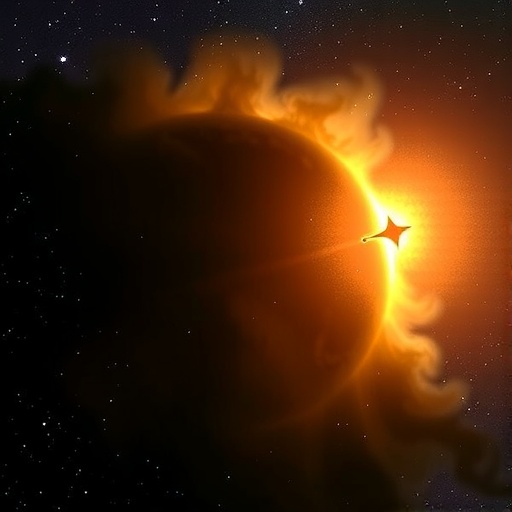A revolutionary plunge into the cosmos has been sparked by a team of astronomers led by Northwestern University, paving the way for an unprecedented understanding of star evolution and death. Utilizing NASA’s James Webb Space Telescope (JWST), researchers have successfully pinpointed the origins of a supernova, dissecting it down to its progenitor star for the first time in mid-infrared wavelengths. This transformative capability marks a significant leap forward in the field of astrophysics, shining light on one of the universe’s most elusive phenomena: the death throes of massive stars.
The analysis centers around the supernova designated SN2025pht. Detected on June 29, 2025, this cosmic event radiates from NGC 1637, a spiral galaxy situated a remarkable 40 million light-years away from our own planet. Previous explorations in stellar evolution had documented red supergiants — colossal stars characterized by their impressive size and luminous displays — but few have been able to unravel the mystery of why these stars rarely transition into supernovae. The JWST’s keen observational prowess has bridged the gap between theory and reality, revealing that these red supergiants do explode, albeit shrouded within thick clouds of obscuring dust.
As the researchers delved deeper, the dust surrounding SN2025pht opened a Pandora’s box of inquiries. Generally rich in silicates, red supergiants like Betelgeuse have long been studied for their explosive potential post-core collapse. However, the JWST uncovered something unexpected: the dust enveloping SN2025pht contained a significant amount of carbon. This finding suggests a beautiful complexity within supergiant stars, pointing towards their ability to dredge up material from their core in their final moments, thus enriching their surface and altering the composition of circumstellar dust.
The observational study, set to be published on October 8 in The Astrophysical Journal Letters, not only draws attention with its thrilling insights but also represents a pioneering achievement for JWST. In a stunning revelation, researchers have successfully identified a supernova progenitor star, clear evidence of the JWST’s potential to illuminate the domains of stellar death that had remained murky for decades.
The discoveries regarding SN2025pht are monumental, specifically as they correlate with longstanding hypotheses about the luminosity of red supergiants. Astronomers have long speculated that these extraordinary stars should be shining beacons in the night sky, detectable enough to spot before their cataclysmic endings. Yet, this has not been the case until the advent of the JWST. The JWST’s advanced capabilities for infrared observation allowed astronomers to penetrate the dust veil that has previously concealed these stars, leading to a revelation that sheds light on the obscured lives of stars destined for a violent end.
Leading this return to astronomical light is Charlie Kilpatrick from Northwestern University, who expressed deep enthusiasm over the technological capabilities that have allowed scientists to gather quality infrared data that transforms past assumptions. The collaboration with graduate student Aswin Suresh exemplifies the power of interdisciplinary teamwork in cutting-edge research. The duo, alongside their collaborators, is thrumming with excitement as they combine the archival power of the Hubble Space Telescope with JWST’s latest observations, resulting in a comprehensive analysis of SN2025pht’s progenitor star.
The findings suggest that the thick cloak of dust enveloping massive stars may be the reason behind their apparent scarcity in the supernovae record. The JWST’s resolution reveals these stars — while immensely luminous — may remain virtually undetectable due to the surrounding dust. The correlation of mass and dustiness emerges as a new trend that may dramatically alter how astronomers approach the study of stellar evolutions and the mechanics of supernovae explosions.
Significantly, the implications of discovering a carbon-rich progenitor extend well beyond this instance. It introduces the potential for a re-evaluation of our understanding of stellar material composition and its cyclical journey, impacting theories surrounding star formation and supernova events. The shift in comprehension is not merely academic; it resonates throughout the scientific community and could very well lead to renewed methodologies in studying the cosmos at large.
The astronomers reinforce that the recent revelations concerning dust properties not only solve long-kept riddles but also raise further questions about how many more hidden stars similar to SN2025pht await discovery. As the team sets its sights on identifying similar candidates for future explosions, anticipations rise for the capabilities the upcoming Nancy Grace Roman Space Telescope will provide. This innovative instrument is projected to hold the resolution and sensitivity required to catch these elusive stars in varying states as they transition towards their explosive endings.
In sum, the study of SN2025pht not only represents a crucial stepping stone towards elucidating the behaviors of supergiants in their final years but also ushers in a new era of exploration. With instruments like the JWST and Roman Space Telescope at our disposal, the forthcoming decades promise a bounty of discoveries that could redefine our understanding of galaxy evolution, star death, and the intricate tapestry of the universe.
As we transcend the boundaries of traditional astrophysical constraints, the revelations of SN2025pht reaffirm an essential truth: the more we learn about the universe’s stars, the clearer the universe’s mysteries become. This work stands as a testament to the power of modern astronomy, revealing that often, the most profound astronomical discoveries are merely waiting beneath a shroud of dust.
Subject of Research: The Type II SN 2025pht in NGC 1637 and its red supergiant progenitor star
Article Title: The Type II SN 2025pht in NGC 1637: A red supergiant with carbon-rich circumstellar dust as the first JWST detection of a supernova progenitor star
News Publication Date: 8-Oct-2025
Web References: [Not applicable]
References: [Not applicable]
Image Credits: NASA, ESA, CSA, STScI, Charles Kilpatrick (Northwestern), Aswin Suresh (Northwestern)
Keywords
Cosmic Events, James Webb Space Telescope, Supernova Progenitor, NGC 1637, Red Supergiant Star, Astrophysics, Stellar Evolution, Dust Obscuration, Infrared Observations.




